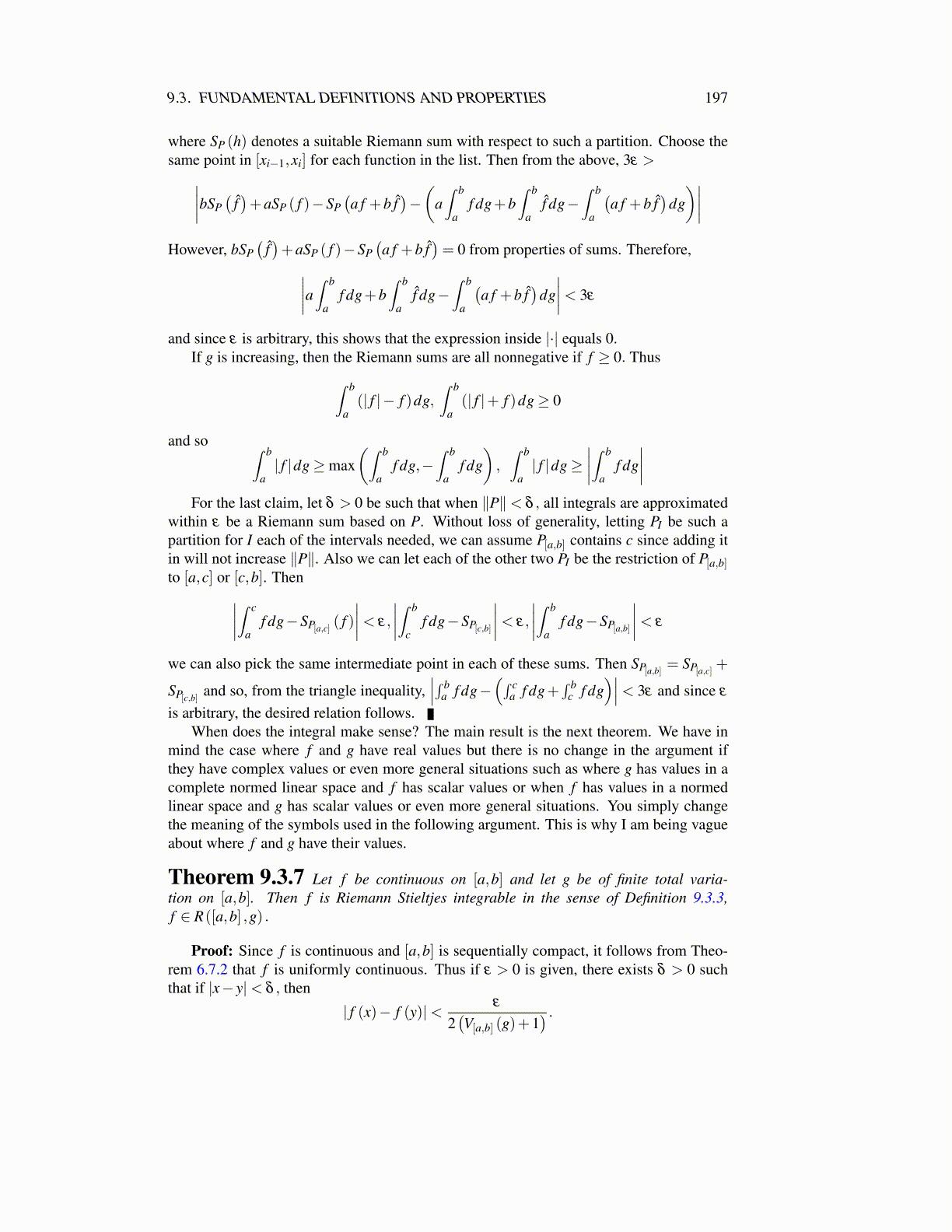
9.3. FUNDAMENTAL DEFINITIONS AND PROPERTIES 197
Now consider a sequence εn→ 0. Then from what was just shown, there exist δ n > 0such that for ∥P∥ ,∥Q∥< δ n, |S (P, f )−S (Q, f )|< εn. Let Kn be defined by
Kn ≡ ∪{S (P, f ) : ∥P∥< δ n}.
In other words, take the closure of the set of numbers consisting of all Riemann sums,S (P, f ) such that ∥P∥ < δ n. It follows from the definition, Kn ⊇ Kn+1 for all n and eachKn is closed with diam(Kn) = εn → 0. Then by Theorem 4.10.15 there exists a uniqueI ∈ ∩∞
n=1Kn. (In more general situations, you would use completeness and a correspondingtheorem which says the intersection of nested closed sets having diameters convergingto 0 contains a unique point. I mention this because this all holds just as well in casethe continuous function has values in an infinite dimensional space in which closed andbounded sets are maybe not compact. We are not concerned with this case in this book.)Letting ε > 0, there exists n such that εn < ε. Then if ∥P∥< δ n, it follows |S (P, f )− I| ≤εn < ε. Thus f is Riemann Stieltjes integrable in the sense of Definition 9.3.3 and I =∫ b
a f dg.Are there easy to apply theorems which will let you conclude that something is or
is not Riemann Stieltjes integrable? This involves the relation between integrability andupper and lower sums. It is specific to the case where f and g have real values and does notgeneralize readily like the above theorem does.
Definition 9.3.8 Let f be real valued, bounded on [a,b], and
P≡ {x0, · · · ,xm}
be a partition with g an increasing integrator function. Then the upper and lower sums aredefined respectively as
U ( f ,P)≡m
∑i=1
Mi (g(ti)−g(ti−1)) , L( f ,P)≡m
∑i=1
mi (g(ti)−g(ti−1))
whereMi ≡ sup{ f (x) : x ∈ [xi−1,xi]} , mi ≡ inf{ f (x) : x ∈ [xi−1,xi]}
Now here is an interesting lemma about partitions.
Lemma 9.3.9 Suppose f is a bounded function defined on [a,b] and | f (x)|< M for allx ∈ [a,b] and let g be increasing. Let Q be a partition having n points,
{x∗0, · · · ,x∗n
}and let
P be any other partition. Then
|U ( f ,P)−L( f ,P)| ≤ 2Mn∥∥Pg∥∥+ |U ( f ,Q)−L( f ,Q)|
where∥∥Pg∥∥ is defined by max{g(xi)−g(xi−1) : P = {x0, · · · ,xm}} .
Proof: Let P = {x0, · · · ,xm} . Let I denote the set
I ≡ {i : [xi−1,xi] contains some point of Q}
and IC ≡ {0, · · · ,m}\ I. Then
U ( f ,P)−L( f ,P) = ∑i∈I
(Mi−mi)(g(xi)−g(xi−1))+ ∑i∈IC
(Mi−mi)(g(xi)−g(xi−1))